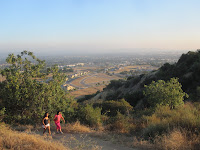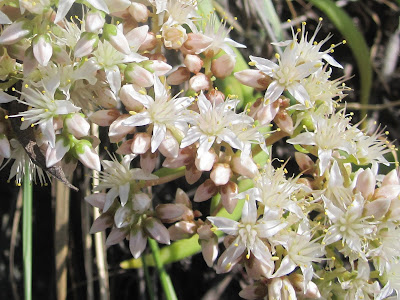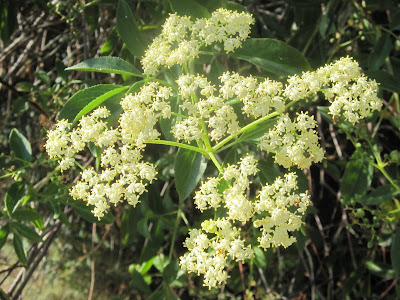 See Garcia Trail Description on Dan's Hiking Pages
See Garcia Trail Description on Dan's Hiking PagesIt’s summertime! Summer 2011 official began in Southern California at 5:20 p.m., June 21. It was a pressing two days for me at work, so I decided it would be great to begin summer with a hike. I got home from work at about 6:30 and by 7:00 I was on my bike heading for nearby Garcia Trail...my default scrappy hike.
 7:22 - Begin hike. The weather is warm and the sun low in the sky. With the sun setting at 8:05, I’m hoping to get a good sunset picture. But I see the sun will be setting behind the mountains stretching to the west and be out of sight long before 8:05, so I’ll have to get the shot from the trail. There is a real beauty this time of day. I’m not paying much attention to plants but some of the blooms include buckwheat, golden yarrow, scarlet penstemon, cliff aster, sunflower, mustard, everlasting, yucca, deerweed, Douglas nightshade, clarkia, fountain grass, tree tobacco, elderberry, and lupine (one occurrence on the summit).
7:22 - Begin hike. The weather is warm and the sun low in the sky. With the sun setting at 8:05, I’m hoping to get a good sunset picture. But I see the sun will be setting behind the mountains stretching to the west and be out of sight long before 8:05, so I’ll have to get the shot from the trail. There is a real beauty this time of day. I’m not paying much attention to plants but some of the blooms include buckwheat, golden yarrow, scarlet penstemon, cliff aster, sunflower, mustard, everlasting, yucca, deerweed, Douglas nightshade, clarkia, fountain grass, tree tobacco, elderberry, and lupine (one occurrence on the summit).  There are lots people on the trail; the majority are young adults. My pace is brisk and I’m working up a nice sweat. The June gloom of this morning has left moisture in the atmosphere creating a distant haze. I am perturbed about the amount of litter along the trail...what is wrong with these people?!
There are lots people on the trail; the majority are young adults. My pace is brisk and I’m working up a nice sweat. The June gloom of this morning has left moisture in the atmosphere creating a distant haze. I am perturbed about the amount of litter along the trail...what is wrong with these people?!7:29 - Arrive into direct sun at the ridge divide past the concrete wall. The sun is starting to dip behind the mountain so I figure this will be my sunset shot. Take a few pics and continue. Various ones stop to look at a tarantula crossing the trail. The beauty of dusk compels me to continue capturing the azure sky. The trail maintenance efforts of the crew from county fire camp 16 on May 9 has made considerable improvement on the trail.
 8:05 - Arrive at Azusa Peak, exactly at sunset, but the sun has long dipped behind the mountains. The Christian flag atop of the large white cross flutters in the breeze. Others arrive at the summit. A new peak register box has been attached to the base of the cross. Looks like it is custom made and quite durable. The human sprawl rests in twilight below. I don’t linger long, wanting to be off the trail before it’s too dark. Leave summit at 8:12. Others are still coming up the trail.
8:05 - Arrive at Azusa Peak, exactly at sunset, but the sun has long dipped behind the mountains. The Christian flag atop of the large white cross flutters in the breeze. Others arrive at the summit. A new peak register box has been attached to the base of the cross. Looks like it is custom made and quite durable. The human sprawl rests in twilight below. I don’t linger long, wanting to be off the trail before it’s too dark. Leave summit at 8:12. Others are still coming up the trail. I enjoy the beauty of dusk and am still drawn to photograph the sky. A blanket of city lights begins to twinkle, but I know my efforts to photograph the panorama will be blurry without taking time to secure the camera. The cool evening air feels good. Crickets chirping. My steps are more guarded as the light dims.
I enjoy the beauty of dusk and am still drawn to photograph the sky. A blanket of city lights begins to twinkle, but I know my efforts to photograph the panorama will be blurry without taking time to secure the camera. The cool evening air feels good. Crickets chirping. My steps are more guarded as the light dims.8:48 - Finish hike. It’s dark now and starting to cool. I’m glad my bike is still locked up to the picnic table. I enjoy the bike ride home, which is mostly downhill!
See Garcia Trail Description on Dan's Hiking Pages
:


















